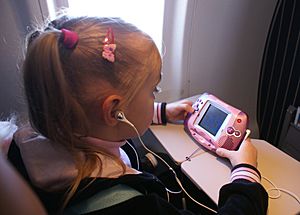Leapster facts for kids
| Manufacturer | LeapFrog Enterprises |
|---|---|
| Product family | Leapster series |
| Type | Handheld game console |
| Release date | October 2003 |
| Discontinued | 2009 (leapster cartridges) 2014 (final discontinuation) |
| Units sold | 500,000 |
| Media | Leapster cartridges |
| CPU | ARCTangent A5 |
| Best-selling game | SpongeBob SquarePants Saves the Day |
| Successor | Leapster2 |
| Manufacturer | LeapFrog Enterprises |
|---|---|
| Product family | Leapster series |
| Type | Handheld game console |
| Generation | 2 remake |
| Retail availability |
|
| Discontinued | 2019 |
| Units sold | 500 |
| Media | Leapster cartridges |
| CPU | ARCTangent A5 (Overclocked) |
| Best-selling game | Learning Path games |
| Predecessor | Leapster |
| Successor | Leapster Explorer |
The Leapster Learning Game System was a special handheld game console. It was made by LeapFrog Enterprises for kids aged 4 to 10. These games helped players learn the alphabet, phonics, and basic math. They also taught about art and animals.
The Leapster had a directional pad and a touchscreen. You could use a stylus pen to tap and draw directly on the screen. This made games interactive and fun.
In 2008, LeapFrog released the Leapster2. This was an improved version of the original Leapster. The Leapster2 added a USB port and an SD card slot. These new features let you download games and save your game data. You could also track what you learned and save your art.
The Leapster Explorer was released in June 2010. Games made after the Leapster2 came out could record what users did. This data was sent to LeapFrog's "Learning Path" system. This system helped track how much a user learned. Completing certain activities could unlock online games. If you created art on the device, you could make it even better online. You could also print your art from a computer. The original Leapster was stopped in 2014, and the Leapster2 was stopped in 2019.
Contents
Games for Leapster Consoles
There are about 40 games available for the Leapster systems. Over 50 games were created in total. This is the largest collection of games for an educational handheld console.
All Leapster games have a "Hint" button. If you press it, you get audio or animated help. This makes it easier to understand game instructions.
LeapFrog mostly made their own games for the Leapster. They did not let many other companies make games for it.
Popular Licensed Games
Many games on the Leapster were based on popular movies and TV shows. Here are some of the games you could play:
- Animal Genius
- The Backyardigans
- The Batman
- Bratz
- Cars
- Cars 2
- Cars Supercharged
- Clifford the Big Red Dog
- Cosmic Math
- Counting on Zero
- Crayola
- Creature Create
- Digging for Dinosaurs
- The Disney-PIXAR Collection
- Disney Princess
- Dora the Explorer
- Foster's Home for Imaginary Friends
- Finding Nemo
- Get Puzzled
- Go, Diego, Go!
- I Spy
- The Incredibles
- Junie B. Jones Journal
- Kindergarten, 1st Grade, and 2nd Grade grade based titles
- El Laberinto De Las Letras (The Labyrinth of Letters)
- Learning with Leap
- Letter Factory
- Letters on the Loose
- Letterpillar
- Madagascar
- Math Baseball
- Math Missions
- Mr. Pencil's Learn to Draw and Write
- My Amusement Park
- NASCAR
- Ni Hao, Kai-Lan
- Noddy (UK only)
- Number Raiders
- Outwit
- The Penguins of Madagascar
- Pet Pals
- The Princess and the Frog
- Ratatouille
- Reading with Phonics: Mole's Huge Nose
- Rock the World
- Schoolhouse Rock!
- Scooby-Doo
- Sonic X
- Spider-Man
- SpongeBob SquarePants
- Star Wars: Jedi Reading
- Star Wars: The Clone Wars: Jedi Math
- Tangled
- Test It
- The Talking Words Factory
- Thomas & Friends
- Tinker Bell and the Lost Treasure
- Toy Story 3
- Up
- WALL-E
- Wolverine and the X-Men
- Word Chasers
How the Leapster Works
The Leapster uses special parts to run its games.
Inside the Leapster
- CPU: The main brain of the system is an ARCTangent-A5 CPU. It runs at 96 MHz.
- Memory: The original Leapster had 2 MB of RAM. The Leapster2 had more, with 16 MB of RAM.
- Games: Games came on cartridges. These cartridges could hold between 4 and 16 MB of game data.
- Graphics: A special ATI chip handled the graphics.
- Sound: The Leapster had its own sound system. It could play music and voices.
- Screen: The screen was 160x160 pixels and had a touchscreen.
- Leapster2 Extras: The Leapster2 also had a USB port and an SD card slot. Some Leapster2 models used built-in memory instead of an SD slot.
All the games for the first Leapster were made using Macromedia Flash MX 2004. The device used a special version of Adobe Flash Player. This made it faster to create games for the Leapster system.


